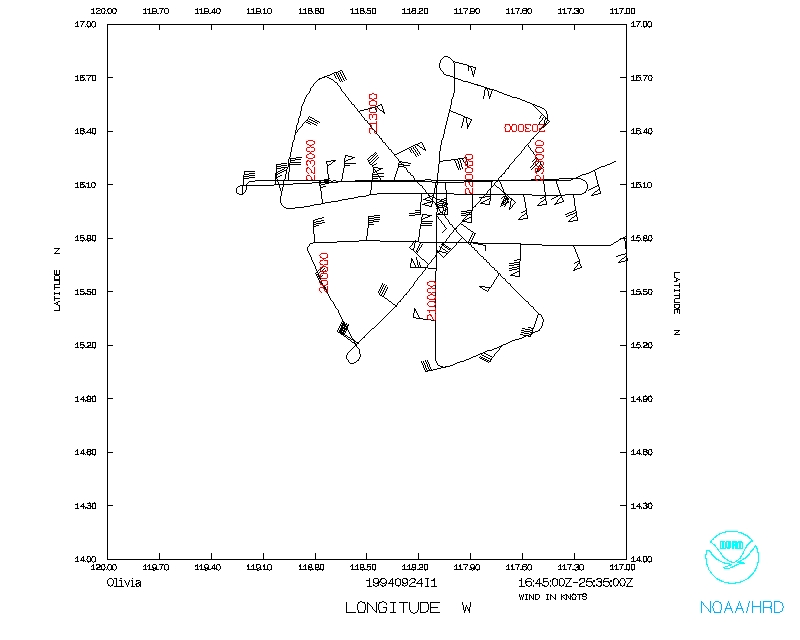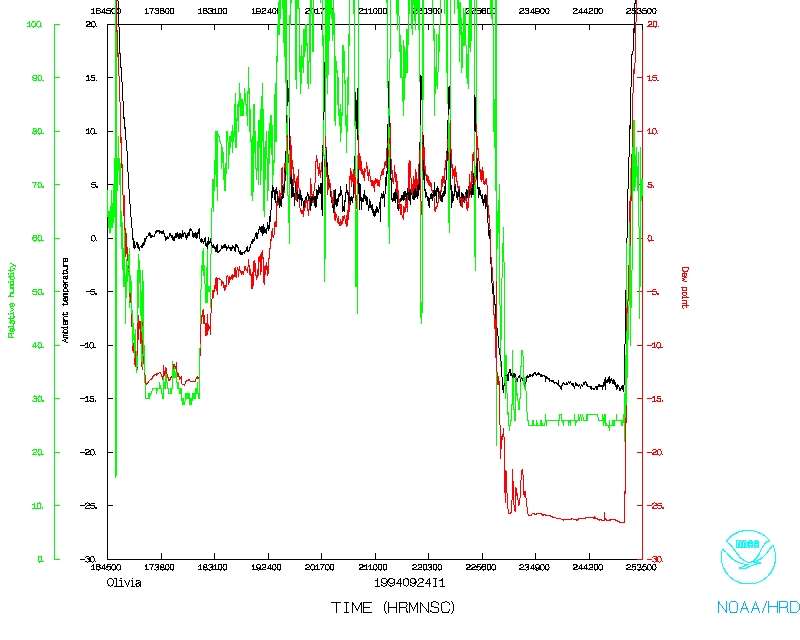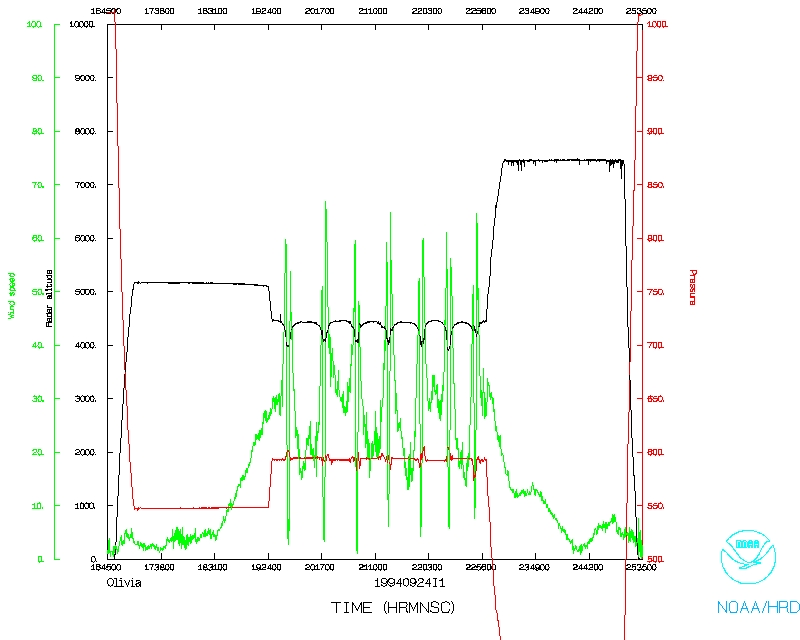Mission Summary
19940924I1 N43RF
Hurricane Cat 3 Olivia 1994
Inner Core Structure and Evolution Experiment
Flight Crew ( N43RF )
| FlightDirectr | Parrish
|
| Pilot | Tennesen
|
| Pilot | McKim
|
| Navigator | Rathbun
|
| FlightEnginer | Bast
|
| Radio | Sans Souci
|
| Data Technicn | Lynch
|
| Electric Tech | Pradas
|
| Electric Tech | Delgado
|
Scientific Crew ( N43RF )
| Lead Proj Sci | Marks | HRD
|
| Radar Science | Willoughby | HRD
|
| Cloud Physics | R Black | HRD
|
| Workstation | Griffin | HRD
|
| Observer | Fremmel | Radian
|
| Dropsonde Sci | Franklin | HRD
|
| Guest | Brad Ohlund | IMAX
|
| Guest | Umberto Fuentes | Mexican AF
|
Mission Briefing :
In the morning of 24 September Olivia was an intensifying hurricane ~680 nm WSW
of Puerto Vallarta, tracking WNW at 5 m/s. Over the preceding 6 h the storm
appeared to be tacking a more northerly track, indicating that the storm might
be starting to recurve. Unfortunately, the storm was too far west (location
15.2N, 117.3W) to be a candidate for the Vortex Motion and Evolution (VME)
Experiment. Hence, we opted for the Inner Core Dynamics Experiment from the
1992 Operation Plan (a forerunner to VME), designed to study the evolution of
the inner core over 3-4 h. We briefed for a takeoff at 1030 local time (1630
UTC). The intended flight tracks were the "rotating Figure 4" pattern with 50
nm radial legs about the storm center. N42RF would enter the pattern from the
N and maintain 5 kft RA throughout the flight, while N43RF would enter the
pattern from the E and maintain 10 kft RA. N43RF would drop one ODW along the
ferry, one ODW at the end of the flight legs in each of the four cardinal
locations around the storm, and one ODW in the eye. If possible, each drop
would include an ODW and a Radian LOD2 for intercomparison.
Mission Summary :
| Take off
| Landing
|
| Puerto Vallarta, Mex
| 16:51 UTC
| Puerto Vallarta, Mex
| 01:31 UTC
|
| 7 penetrations
|
The flight took off from Puerto Vallarta, Mex at 1651Z on 09/24/1994 and
landed at Puerto Vallarta, Mex at 131Z the next day with departure from
Puerto Vallarta was delayed until 1652 UTC. The approach to Olivia was from the
E with an expected ETA of 1900 UTC near 15.4N 118.4W, with an IP 50 nm E of
that position. The ODW/LOD2 drop along the ferry was canceled because of a LOD2
system failure. At 1910 UTC, ~200 nm from the IP, we fixed the center with the
lower fuselage (LF) radar at 15.7N 117.9W, farther N and approximately 40 nm
closer to Puerto Vallarta than expected. The LF indicated that there was a
definite eye 15-20 nm in diameter with relatively intense reflectivity in the
S quadrant. There was a principal rainband spiraling from 50 nm NE of the
center out to ~100 nm SW of the center. John Gamache and I decided to adjust
the aircraft altitudes because of the small eye size and the intense
reflectivities. N42RF would maintain 10 kft PA and N43RF 14 kft PA. PA was
chosen because of a RA failure on N43RF during the ferry.
N43RF reached the IP (15.75N 117.1W) at 1933 UTC, dropped an ODW just
outside the principal rainband, and tracked W across the eye encountering 122
kts winds in the E eyewall. Both aircraft crossed the center of the eye 1944
UTC, within 15 s of each other, fixing the center at 15.8N 117.9W. The eye was
relatively clear below the aircraft altitude, but was covered by thin cirrus.
The inner edge of the eyewall cloud, at a radius of ~9 nm from the center, was
not very distinct, with a lot of cloud protruding into the eyewall above the
aircraft altitude. The second ODW was dropped at the westernmost point in the
first leg (2) in the midst of a number of weak rainbands embedded in an
extensive stratiform rain region that extended ~200 nm S and W of the center.
The second leg was from a point 50 nm SW of the center (2), on a NE
track through the center. In the SW portion of the eyewall we encountered a
very broad (50 s) updraft >10 m/s, with a peak 1-s value of 21 m/s. The updraft
was just upwind of the most intense reflectivities in the S quadrant of the
eyewall. We passed through the eye at 2019 UTC (15.85N 118.0W), within 10 s of
N42RF and encountered 126 kts winds in the NE eyewall. The radar system failed
at 2032 UTC during the downwind leg to a point 50 nm N of the center (5). We
orbited at 5 until the radar system was restarted and then started our third
leg at 2042 UTC, dropping an ODW at 5. We passed through the eye at 2052 UTC
(15.9N 118.1W), within 15 s of N42RF. We encountered heavy rain, graupel and
lightning as we passed through the intense reflectivity in the S eyewall,
dropping another ODW at the point 50 nm S of the center (6). On leg 4, which
started 50 nm SE of the center (7), we encountered heavy rain, graupel and
lightning once again. We dropped an ODW in the eye at 2124 UTC (15.95N 118.15W)
as we saw N42RF pass beneath us. The splash pressure was 950 mb.
We finished up the day with three legs oriented E-W across the center.
The first E-W leg started at 2145 UTC, 50 nm W of the center (2), passing
through the eye at 2155 UTC (16.05N, 118.2W). The second E-W leg started at
2209 UTC 50 nm E of the center (IP), passing through the eye at 2223 UTC
(16.1N 118.3W), 20 s ahead of N42RF (the worst synchronization of the day).
The final E-W leg started at 2238 UTC at 2, passing through the eye at 2248
UTC (16.15N 118.4W), 6 s behind N42RF (the best synchronization of the day).
At 2300 UTC we ended the pattern at 1 and climbed to our ferry altitude back
to Puerto Vallarta. The navigator computed a storm motion of 310 deg. at a
speed of 8 kts over the three hours of the experiment.
Mission Evaluation and Problems :
Fantastic flight!! Bob Burpee says that the mission was probably one of the
4-5 best missions HRD/AOC has flown in the last 15 years. The aircraft
coordination was outstanding, with the AOC flight directors and navigators
deserving the lion share of the credit. Achieved seven complete mappings of
the inner core within 50 nm radius of the storm center for true dual Doppler
analyses over a 3.5 h period. The EVTD analyses performed on the aircraft
showed that the storm was intensifying during the mission, with the azimuthally
-averaged tangential winds increasing from 50-55 m/s on the first pass through
the center, to over 60 m/s by the last pass. As the wind speed increased, the
radius of maximum winds contracted, from 20 km radius on the first pass through
the center to 16 km radius on the last pass. Six ODWs were dropped as planned,
of which all were either good or recoverable. The ODW drop in the eye (950 mb
central pressure) showed similar structure to those dropped in the eye of
Hurricanes Gloria, Emily and Gilbert. There was a distinct inversion at ~875
mb, with relatively warm dry air above the inversion and nearly saturated air
below.
This data set will be outstanding for studies of inner core dynamics and
evolution. The storm's small size and intensity, were ideal for this
experiment. The inner core out to at least three eye radii distance were
within the domain mapped by the Doppler radars. The seven complete mappings
over the 3.5 h (one analysis every 33 min) while the storm was intensifying
should provide an excellent opportunity to study the temporal evolution of the
primary and secondary circulations in the eyewall. These data should also help
improve our understanding of the interaction of the inner core and the
environment as the storm starts to recurve.
N43RF also transmitted three radar composites and 5 of the 6 ODWs back
to NHC via ASDL. All the radar composites were received and decoded for the
hurricane specialists. They were very happy to receive all the information as
it confirmed that the storm was intensifying and starting to recurve.
Frank Marks
Wednesday, October 25, 1995
Mission Data :
1 second data
Flight Director log |
Lead Scientist log |
Miscellaneous |
Radar log |
Cloud Physics log |
Dropsonde log
Data Tapes
| Radar | 2 | 1855 Z | 55 Z |
| PMS cloudphy | 1 | 1921 Z | 2300 Z |
| OAO Standard | 1 | 1642 Z | 137 Z |
| Fast | 1 | 1719 Z | 137 Z |
Videos
| Nose video | 1 | 1640 Z | 132 Z |
| Left video | 1 | 1640 Z | 132 Z |
Return to Olivia 1994 page .


